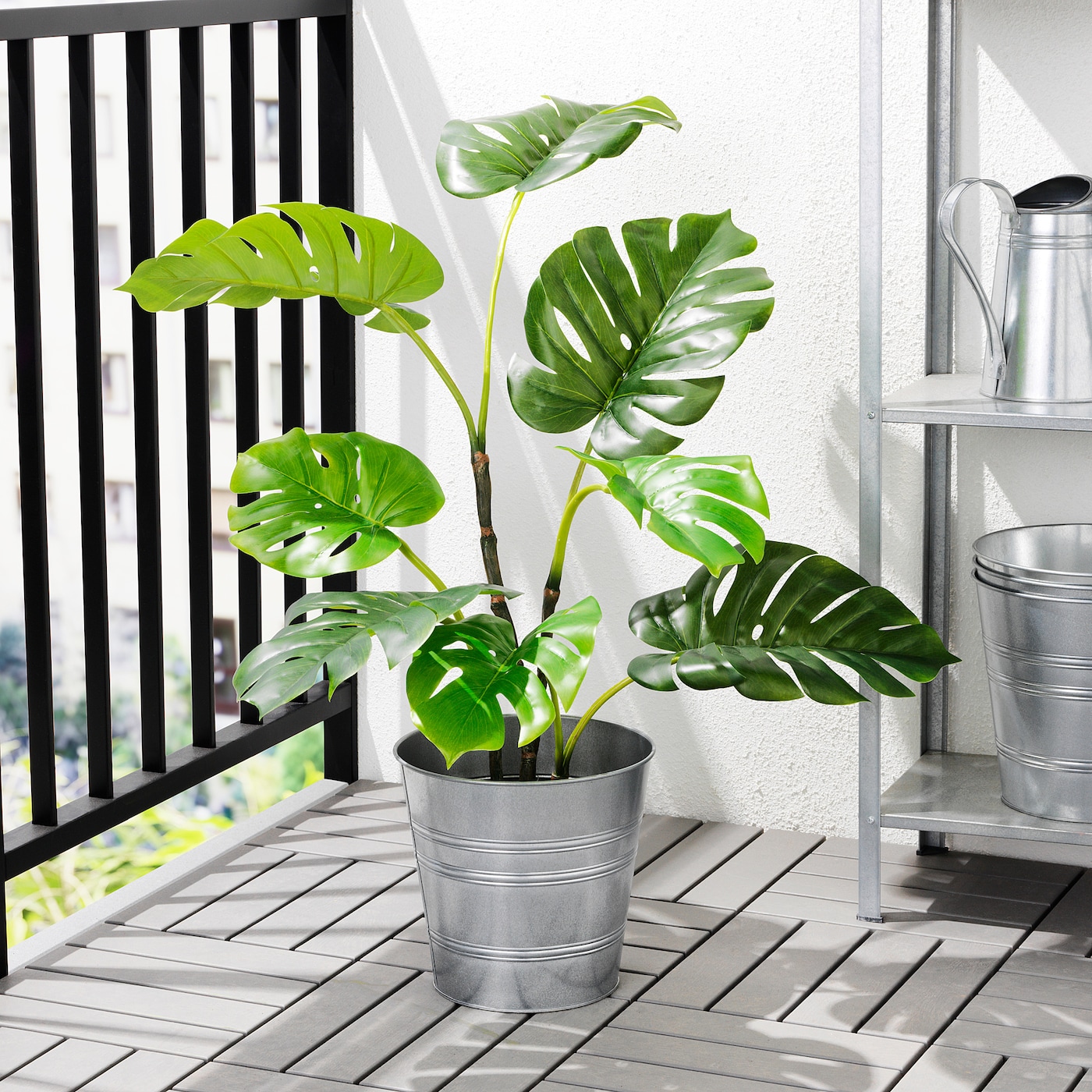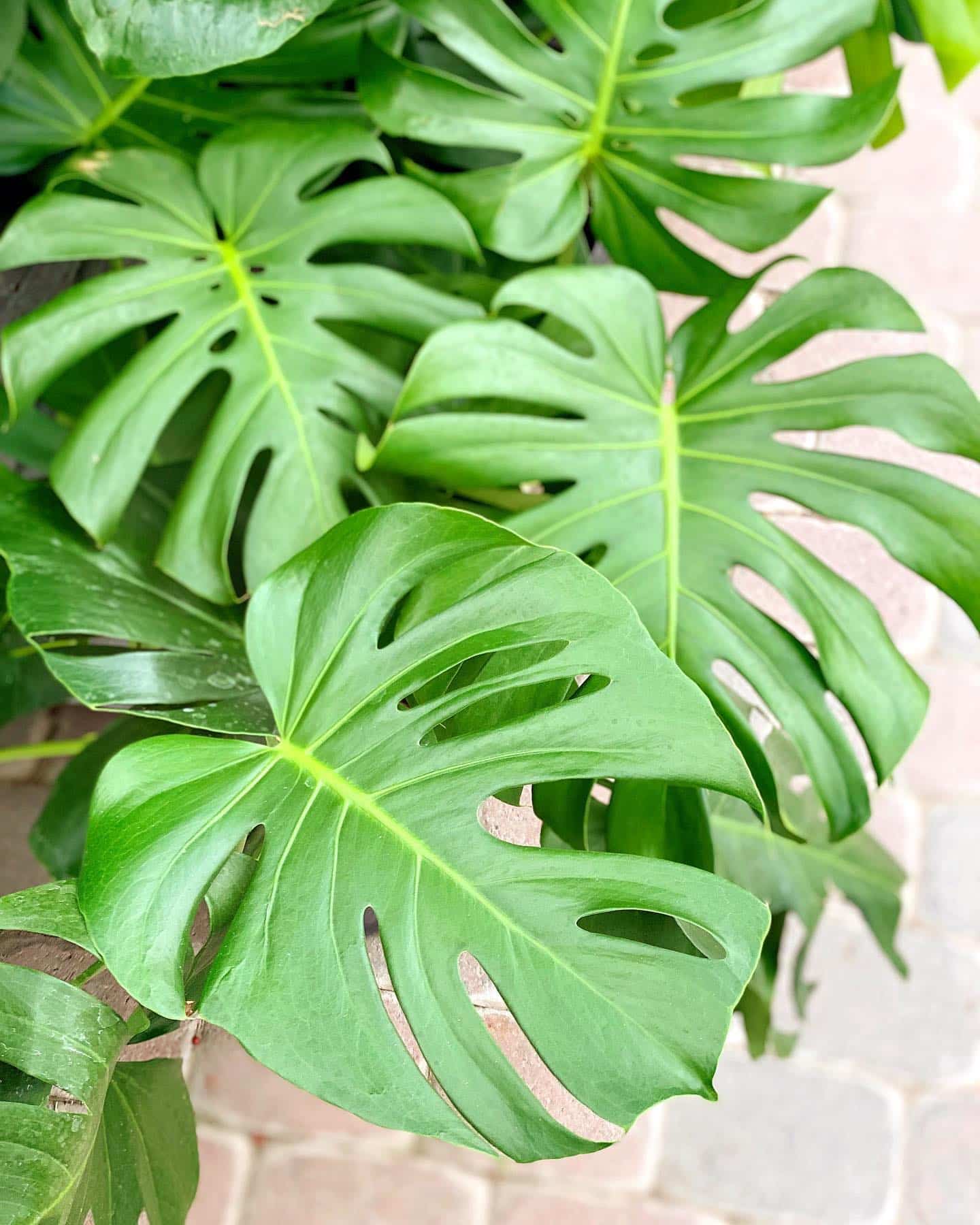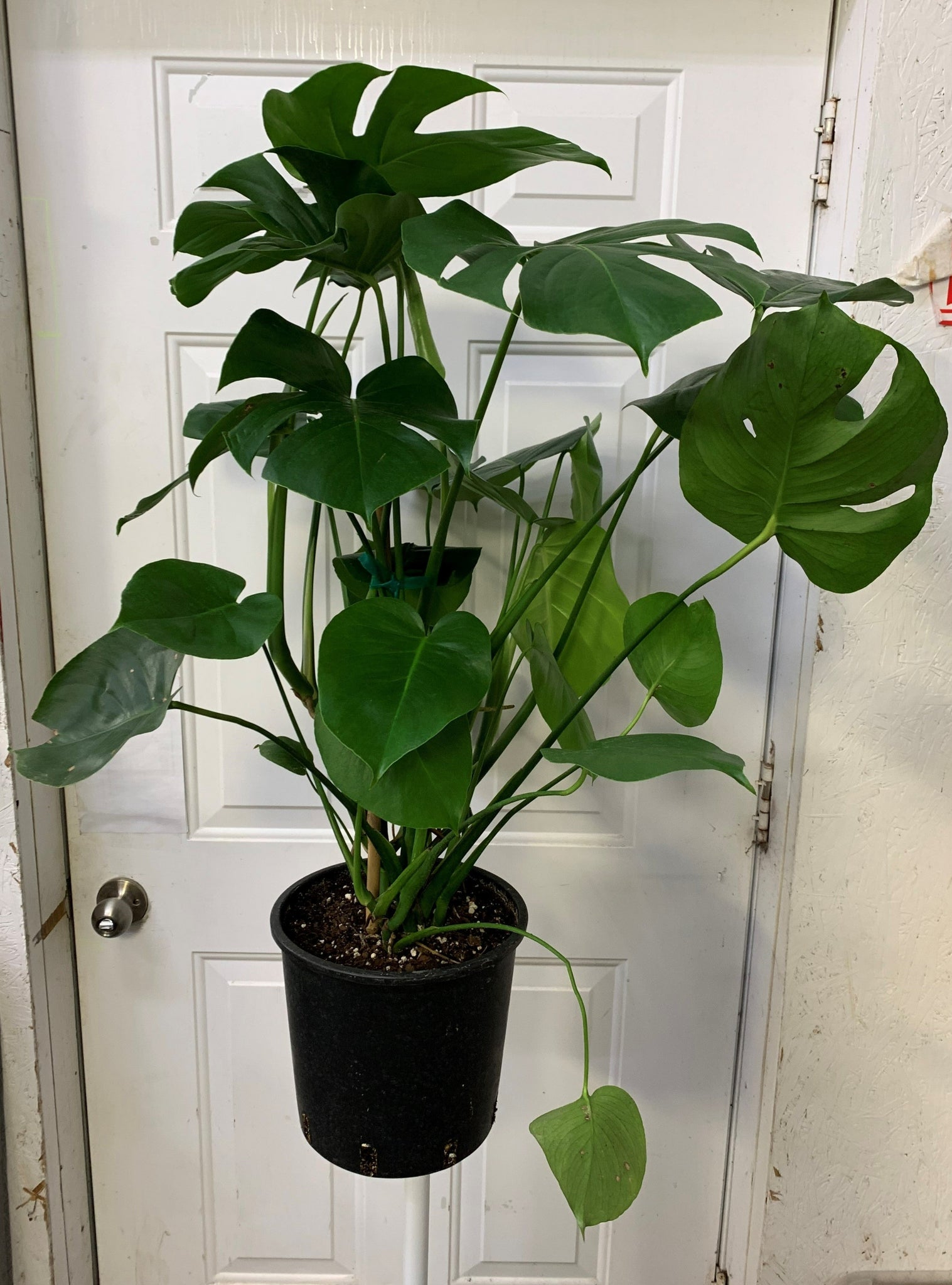Monsteras are a robust plant, but if they become dissatisfied at any point, they will display a variety of leaf indications. Numerous factors can cause black spots to appear on monstera, which has been an issue for decades.
Most Regular Cause of Over fertilization might result in black patches on monstera leaves. Sometimes we want the plant to grow bigger, healthier leaves, which means it needs nutrition. If you fertilize your monstera plant excessively, black spots will develop on the leaves.
The top 9 causes of brown and black stains on monstera leaves are shown below:
As a result of harsh environmental conditions, monstera plants frequently exhibit brown and black marks on their leaves as a symptom of stress. The good news is that monstera plants can survive being killed and can eventually regrow. There are additional causes for the monstera leaves to get infected. Monstera leaves can be yellow, orange, or red in addition to their usual color of green.
Because they are both tropical plants with lengthy leaves, they are frequently mistaken for philodendron leaves. Black patches on monstera leaves are possible, and a fungus or bacteria may be to blame. Additionally, they may have brownish stains on them, which are caused by a fungus or bacteria.
Table of Contents
9 Reasons for Black Spots on Monstera Leaves:
1 . Black Spots on Monstera due to Over-fertilizing
Most Regular Cause of Over fertilization might result in black patches on monstera leaves. Sometimes we want the plant to grow bigger, healthier leaves, which means it needs nutrition. If you fertilize your monstera plant excessively, black spots will develop on the leaves.
Once a month, from spring to summer, when the plants are actively growing, fertilizer or plant food should be applied. Stop fertilizing excessively for the time being and watch what happens if that is the cause of the issue.
2. Black Spots Appear Due to Overwatering
Black patches on monstera leaves can often be attributed to overwatering. The slow process of root rot may be started when novice gardeners become overly enthused and pour too much water. But you shouldn’t worry any longer because it can be fixed by taking certain actions.
If your monstera is overwatered, you might notice a several indicators.
How to Solve
If your monstera is significantly overwatered then merely remove the plant from the pot first. After that, clean the intact dirt around the roots. You can prune the root system after gently cleaning it. Sterilize the cutting instrument first to prevent the monstera roots from becoming infected. Cut all the roots that are dark, brown and black it reveals that they are excessively damp and infected. These decayed roots are unable to develop and instead infect healthy roots.
Now wipe your saucepan with your hands and dust cloth. once the dirt has been removed. Place it on the balcony where it may receive sunlight so that it can dry completely. This way, the sun’s natural light will kill any fungus or bacterial growth.
The pot can be used again for the plant after three to four hours in the sun. However, you can immediately use a new pot and soil mixture for your monstera instead of waiting. So that all the extra water may drain, the pot needs to have a drainage hole.
Next, remove all of the dead leaves from your monstera plant. Keep this plant in a spot with some light, and allow it to regrow with the same strength.
Check the soil before watering it to prevent excessive overwatering. Always inspect the top 2-3 inches of soil to see whether or not it is damp. If it’s dried, give your plant a thorough watering. This is the solution that works in most plants.
3. Root rot
Root rot is one of the symptoms of over irrigation. If Monstera is left in wet soil for an extended period of time, root rot can readily strike. Sometimes we believe that we can only provide the water in the same manner as we did one month prior. But every time, it gets harder because of the temperature and environment changes. There can be hot sun on one day and on other days it is freezing. Only when the soil is dry do you need to provide water.
When something is wrong with a Monstera deliciosa’s roots system, black patches on the plant may exhibit a few symptoms, such as yellow or brown tips. It is not possible to rescue your plant if the leaves of your plant have totally turned black.
Only if two or three leaves are harmed is the issue only halfway solved. You can examine the roots and determine the extent of the damage visually.
How to solve
Check the root to see whether it has become black or brown before removing the plant from the pot. White or gray leaves that are in good health are possible. Simply chop those roots off if it’s dark. In addition, before taking cuttings, clean the pruner. Also remove all of the diseased leaves that have lost their pigment and are discolored.
Now, if your soil is overly wet or dripping with water, remove it, replace your potting soil, and throw away the old dirt. Finally, water the monstera after planting it in the fresh soil. In a few days, you can observe that it begins to grow once more.
4. Monstera Black Spots due to Temperature Stress
As you are aware, every plant needs a stable temperature during the growing season. They develop better and generate more vibrant leaves when they receive the ideal temperature for their needs.
Tropical plants like monstera have the strength to grow properly due to the mild temperatures they receive in areas with partial shade to indirect light. Additionally, it prevents the development of black spots, which typically result from changes in temperature, such as when the leaves are burned by intense sun or when it is cold.
5. Black Spots on Monstera due to Cold Temperature
Your monstera needs a minimum temperature of 55 degrees F for a cooler climatic area, and anything below that could cause issues. I am aware that many people worry about the heat, but there are also issues with the cold that need to be addressed. The plant freezes in colder temperatures, and if it is harmed by low temperatures, it won’t have the energy to function in such extreme cold. If your plant suffers from frost damage and doesn’t receive enough nutrients from the roots to the top, the leaves could turn black, become mushy, or even die.
Additionally, it stunts development, destroys young branches, and causes black patches to emerge whenever there are signs of trimming. This type of temperature promotes the rapid growth of fungal diseases, which affect plant roots and may cause plants to succumb to illnesses.
How to Solve Cold temperature
Keep your monstera plant indoors, near a heater throughout the winter. Because the indoor temperature is sufficient for the plant to survive for a while, you also don’t need a heater. After you lock the doors and windows where the cold winds entered, the room’s temperature returns to normal. Your plant needs a temperature of 65 to 75 degrees Fahrenheit indoors, but if you keep your room no lower than 50 degrees, it will thrive without a doubt.
6. Hot Temperature
Many people who are new to gardening are unaware that these plants dislike direct sunlight, therefore they nevertheless place them in hot climates where the sun is shining directly on the plant. Following that, your plant can experience sunburn, which is a regular error. The monstera was placed in front of a window or on a balcony where it received direct sunshine by many others who had heard about growing it indoors. The leaves become dry, crispy, and occasionally develop a few black spots, which makes it difficult for the plant to continue to grow.
Few other people place them outdoors in flowering plant gardens with the hope that it would flourish and look great with these lovely plants. However, your monstera begins to feel dry, and some of it begins to wilt and droop. As soon as you notice some of the black tips, patches that develop as a result of intense sunlight.
How to Solve
The answer is straightforward: put it indoors close to a south-facing window. It should receive a few hours of morning sunlight followed by all day long indirect light from shade. This will promote healthy plant growth and provide it all the warmth it needs inside. If you ever move it, be sure to do so in a room with plenty of indirect light.
7. Dehydrated Soil
This kind of issue affects all plants and causes them to steadily deteriorate over time. With this problem, you could see various symptoms as well as a lifeless-looking plant. When a monstera plant is dehydrated, there is very little water left on the plant to keep it growing, whereas thick, yellow monstera leaves indicate overwatering.
The majority of folks enquire as to why my monstera leaves start to turn crisp and develop black spots. Your plant may not look well in low water and may appear stressed due to underwatering or lack of watering. Neglecting your mostrea will often manifest as dark leaves, crispy edges, and a few droopy leaves, among other symptoms. However, leaves that are growing far from the main stem may appear to be wilting and dying. This problem may not affect leaves that are growing below or close to the bottom stem.
How to Solve
Your mostera need water right away if they appear wilted, have black spots, or have crunchy leaves. When this occurs to my plants, I always make sure they receive enough water to the point when the water drains out of the bottom pothole. You can also thoroughly water the top soil to ensure that the roots receive moisture wherever they are. In this manner, your plant will be able to nourish and supply water to different areas of the plant.
If you’ve placed your plant in a spot with only partial light, it may frequently dry up, therefore you should water the monstera sometimes whenever the soil gets parched. If the water is not draining out, another option is to alter the soil mixture. You can also repot monstera into a different container to give it more room and access to water. People who were growing them in indirect light don’t have this issue because under low light, it will take longer for your plant to dry up the soil.
8. Insufficient Sunlight
The aforementioned factors, such as excessive watering, root rot, temperature stress, and moist soil, are all related to one another. Your plant cannot produce enough food through photosynthesis as a result of the insufficient sunshine, which causes a number of issues.
Your monstera leaves may show signs of insufficient sunshine by becoming yellow, mushy, or developing dark blotches in the middle of the foliage. Chlorophylls, as you may know, give green things their color, but without sunshine, this is not possible, thus leaves become discolored or appear to be going dark.
How to solve
Changing the location to a partially lit area is the first stage. Your monstera’s health can be greatly improved by early morning exposure to natural light. Do not leave it out for longer than three hours because it dislikes intense, direct sunshine. In the absence of this, leaf scorch on entire leaves may occur in a few days. Always moisten your plants in direct sunlight to keep them alive, but it also works on plants that can tolerate some sun.
9. Pest Infestation
Pests can be inconvenient and may cause problems for both your indoor and outdoor growing plants. In the instance of monstera, which has some pest resistance. What if a whole army is standing by, ready to chomp on the plant leaves? Until all of its leaves are lost, the plant may drop one leaf every other day. Thrips and spider mites, which bit the leaf and drained it of all juice, are what I’m referring to. The sap from a healthy leaf can be completely removed by these tiny, vile insects, which have six legs.
By using my advice, you can keep your plants safe from these pests. But first, let me describe these two pests to you so you are aware of what they are.
Thrips
Thrips are tiny insects that resemble flies that drain the water completely from the leaf, drying out the monstera. They are in charge of the fading of pigment. They make the leaf gloomy, and occasionally you can see black patches emerging and making the leaf dead.
Spider mites
In general, pests that resemble spiders and have numerous legs are not considered insects. They are pests that eat leaves and feed on plant sap. Because they destroy the leaf’s cell wall when they extract the juice, the area of the leaf turns dark black, yellow, or occasionally brown.
The monstera leaves may eventually develop a few black dots in this manner, and you will need to remove any leaves that have been affected by these two parasites.
How to solve
I might just use water force to get rid of spider mites. To get rid of them, you can also use soap solution, which occasionally works. Spider mites may have spun silk webs if you have monstera indoors. This is why spraying this kind of insect with powerful water is effective.
Neem oil, which you can apply to your plant leaves every other day, is effective against thrips. Additionally, it is advisable to prune any completely damaged leaves to slow the spread of the illness.
Another solution to the thrips and spider mites issue is a pesticide.
10. Dark Spots Due to Diseases
Both bacterial and fungal diseases can cause leaf spots on monstera plants. The fungus colletotrichum sp., which produces round and oval notoriety pieces on the upper layer of the leaf tissue, is the culprit. Your plant’s leaves turn brown and yellow, and some of them may curl before falling to the ground. As soon as the fungus seizes control of the leaf tissue, it consumes all of the nutrients and water molecules still there, leaving the leaf dried out and pliable. The leaf begins to fade and turn dark after there is nothing left of it. On the leaves, the fungus also produces black oval-shaped patches. If it’s not stopped, it can also spread to your other plants.
Observe these symptoms to stop it before it’s too late since if the fungus covers the entire foliage, it can spread to other indoor and outdoor plants.
How to Solve
You must remove all the diseased leaves in order to solve this disease condition. For this, use transparent, sterilized pruners. First, get rid of all the light-colored, dry, brown, yellow, and blackish leaves. Look at more nearby plants for signs of illness and remove them if you find any. Both bacterial and fungal diseases will no longer spread as a result of this.
Another piece of advice I’d like to provide you is to never spray or allow water droplets sit on monstera leaves. Never mist your plant from the top; instead, constantly saturate the soil with water. Simply clean any remaining water from your plant’s leaves to help it avoid contracting any diseases.
Should I Remove Leaves That Have Black Spots?
If the cause is excessive watering, intense light, humidity, or temperature, I advise you to wait until the plant recovers after using the remedy. Yes, you must eventually remove those leaves because they give your plant an unsightly appearance that you don’t want others to view. Removing it promotes growth, conserves nutrients, and also stops the spread of any potential diseases in the future.
Black Spots Monstera Care
I realize it may be upsetting to see your monstera’s plethora of brown and black patches. An unpleasant reality is that it won’t turn green once more. I have this problem, and I take proper care of it by removing those contaminated leaves and avoiding this. Trimming brown and black leaves may initially prevent this problem, but understanding how to prevent it will essentially help to manage similar issues in the future.
Don’t trim off those leaves if you notice little spots that are actually caused by pests; if you get rid of the pests, the plant will be able to produce more food through photosynthesis.
If you meet all of your monster plant’s requirements, black and brown blotches are simple to avoid. I’ve created a table with some of the key points I need to remember below.
| Sunlight | They prefer Indirect light, Avoid Direct Sunlight |
| Water | Once in a week(Check soil conditions before watering) |
| Fertilizer | Once in a month During Summer and Spring |
| Humidity | They like moderate humid conditions( Do not pour any water spray on the leaves) |
| Temperature | 60 to 85 degree °F (16 – 30 °C), Temperature should not in below 50 °F(14 degree °C) |
Wrap Up
Blackening of Hydrangea Leaves: A Leaf Disease (With Solution)
Meaning of the Black Lotus Flower: Symbolism, Tattoo, and Spiritual Indications



